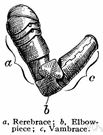vambrace
Also found in: Thesaurus, Wikipedia.
vam·brace
(văm′brās′)n.
A piece of armor used to protect the forearm.
[Middle English vambras, from Anglo-Norman vauntbras : vaunt (variant of Old French avaunt, before; see vanguard) + bras, arm; see bracer2.]
American Heritage® Dictionary of the English Language, Fifth Edition. Copyright © 2016 by Houghton Mifflin Harcourt Publishing Company. Published by Houghton Mifflin Harcourt Publishing Company. All rights reserved.
vambrace
(ˈvæmbreɪs) orvantbrace
n
(Arms & Armour (excluding Firearms)) a piece of armour used to protect the arm
[C14: from Anglo-French vauntbras, from vaunt- (from Old French avant- fore-) + bras arm]
ˈvambraced adj
Collins English Dictionary – Complete and Unabridged, 12th Edition 2014 © HarperCollins Publishers 1991, 1994, 1998, 2000, 2003, 2006, 2007, 2009, 2011, 2014
vam•brace
(ˈvæm breɪs)n.
armor for the forearm.
[1300–50; Middle English va(u)mbras < Anglo-French (a)vantbras=avant- fore- (see avaunt) + bras arm (see brace)]
vam′braced, adj.
Random House Kernerman Webster's College Dictionary, © 2010 K Dictionaries Ltd. Copyright 2005, 1997, 1991 by Random House, Inc. All rights reserved.
ThesaurusAntonymsRelated WordsSynonymsLegend:
Switch to new thesaurus
| Noun | 1. |  vambrace - cannon of plate armor protecting the forearm vambrace - cannon of plate armor protecting the forearmbody armor, body armour, cataphract, coat of mail, suit of armor, suit of armour - armor that protects the wearer's whole body cannon - (Middle Ages) a cylindrical piece of armor plate to protect the arm |
Based on WordNet 3.0, Farlex clipart collection. © 2003-2012 Princeton University, Farlex Inc.